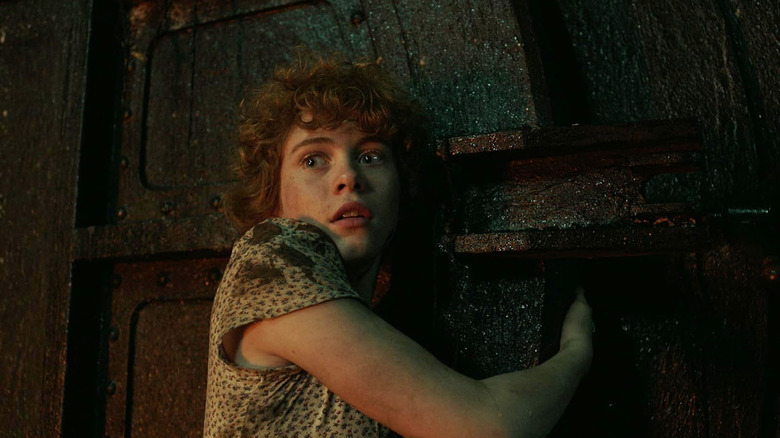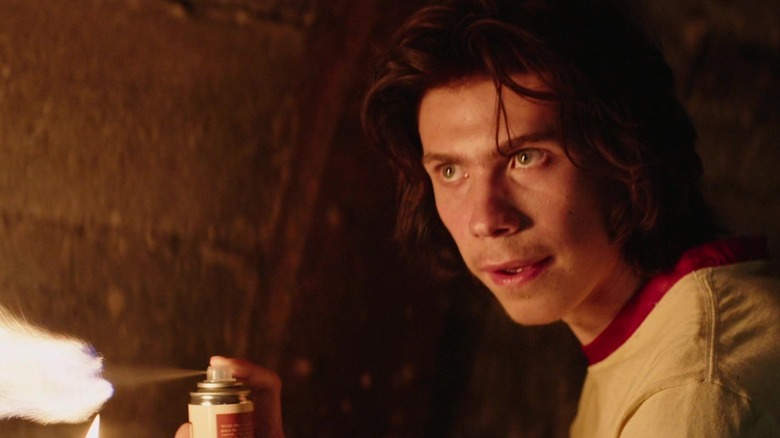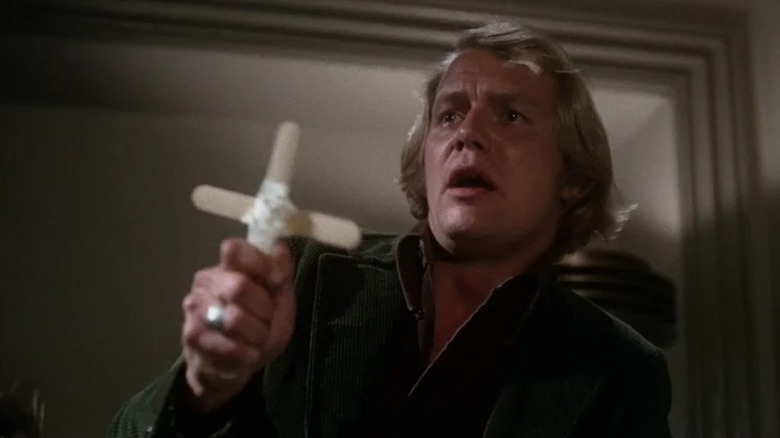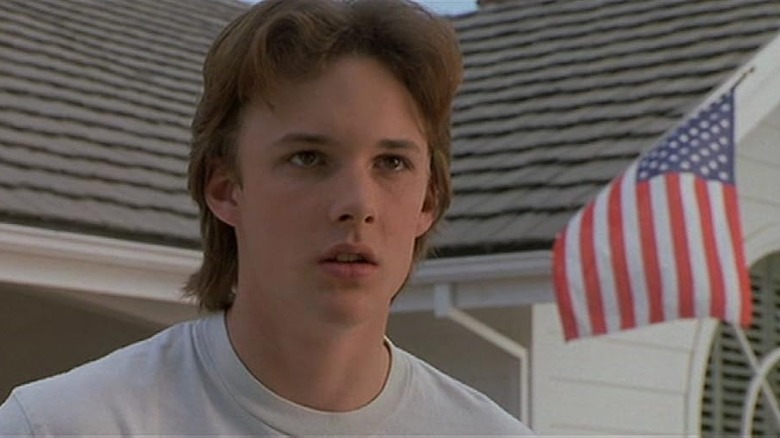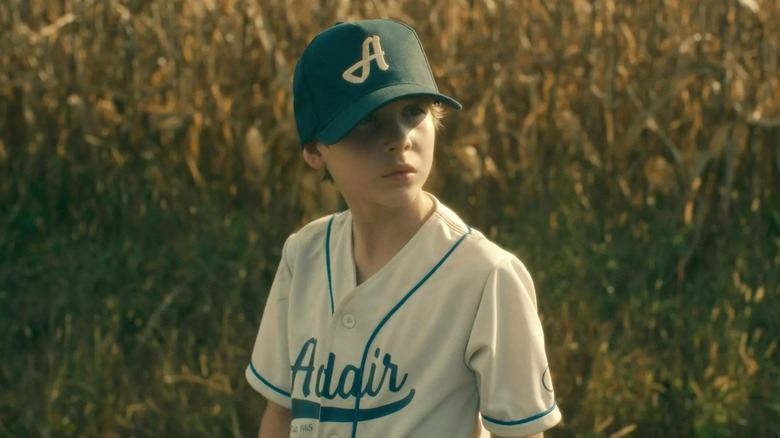Controversial Stephen King Book Moments That Will Likely Never Be Adapted
This post contains spoilers for all mentioned works of Stephen King.
Every Stephen King reader has one: a moment in one of his stories that makes you want to curl up and cry, throw the book across the room, or maybe just stare blankly at a wall until you can feel okay again. More often than not, the inciting incidents here are not the moments involving the prolific horror author's most famous supernatural monsters, but the ones that involve people at their most evil. And in the world of Stephen King, people can be so much worse than monsters.
A transgressive writer to his core, King relishes the breaking of taboos; some of his most famous stories include descriptions of child death, pet torture, brutal rape, and virulent racism. Sometimes these passages work in service of the story — "Pet Sematary" and "Cujo" wouldn't be masterpieces without the kids in peril — but sometimes they feel out of place, out of touch, or mean-spirited in a way that feels like a misjudgment on King's part. It's these scenes, more than any others, that seem least likely to make it to screen in a future film or TV adaptation.
Still, to debate what is or isn't adaptable from the world of King is to put barriers on a format that has largely embraced his most disturbing elements. The hobbling of Paul Sheldon came to life in the "Misery" movie, while Mike Flanagan's "Doctor Sleep" made the Baseball Boy death scarier than ever. Just a few years ago, "IT Chapter Two" opened with a horrific, controversial hate crime sequence that had previously seemed unfilmable, while Flanagan's "Gerald's Game" adaptation managed to include one of the most horrifying scenes in the Kingverse — all while balancing a plot involving BDSM and molestation. Hell, even one of King's nastiest tales, the desert island short story "Survivor Type," seems like it could end up on screen in a post-"Hannibal" world.
The power of movie magic can often overcome the "unfilmable" label, but there are still a few King scenes that deserve to stay on the cutting room floor. Here are five of them.
The child orgy and infanticide in IT
One of King's magnum opuses is also the home to his most disturbing literary sin. It comes near the end of 1986's "IT," when the kids the book has spent hundreds of pages building up so thoroughly that it feels as if we know them all suddenly start having sex with each other in a sewer. Or more accurately, all six boys have sex with virginal Beverly in turn. It's meant to be symbolic or meaningful in some way (the act helps them after they literally get lost in the darkness), and it's described as consensual, but everyone involved is also a preteen. To make matters more disgusting, the entire book has featured a looming sexual threat towards Beverly in the form of her father, and the underage group sex seems to somehow be (unsuccessfully) positioned as a liberation of sorts, or a reclaiming of control.
Neither of the onscreen adaptations of "IT" have touched this scene with a 10-foot pole, and for good reason. Upsetting descriptions of child sex aside, it doesn't make thematic sense, so even a milder reimagining — say, Beverly giving each boy a kiss in the dark — would still feel like an exploitation of and disservice to her character. King has tried to rationalize this scene by noting that it's interesting fans react more to it than to the child murders in the book, which isn't really true. Plus, the violence in his books isn't typically portrayed as loving and positive in tone, as this repulsive scene is.
This isn't the only scene in "IT" that seems unlikely to ever make the leap from page to screen. A chapter revealing the backstory of teen sociopath Patrick Hockstetter is also wildly disturbing, with passages detailing him trapping pets in an old refrigerator to suffocate or starve and smothering his infant brother to death. The latter scene takes place when Patrick is just five years old, and he casually watches TV afterwards, allowing his family to discover the body and conclude that the baby died of SIDS. As horrific as the Patrick scenes are, there are ways they could be portrayed on screen. But "IT" is so jam-packed with awful, traumatizing sequences that it makes sense that these ones, which would push an adaptation from bleak into unbearable, regularly end up left on the shelf.
The baby abuse in Salem's Lot
There's a scene early in vampire novel "Salem's Lot" that is so startling and upsetting that it made me put the book down for months. It's not particularly central to the plot, but is designed to add texture to the town of Jerusalem's Lot, helping readers understand that casual violence and neglectful parenting are part of the complicated fabric of this deeply American, deeply broken place.
In the scene, a woman, Sandy McDougall, punches her baby. There's not much more to the moment than that, although King puts readers inside the head of this woman, whose anger at her infant child is both unnerving and — thankfully — deeply foreign to most of us. To tell a story of postpartum depression, anxiety, or anger is one thing, but to introduce us to a new mother, only to describe her physically going against everything we've ever learned about the parent-child bond — committing violence against her own extremely fragile and defenseless baby — is another entirely.
The infant abuse scene is horrifying, but it's also superfluous in the grand scheme of the novel. Another, later scene featuring the same baby is scary and shocking for a different reason, and of the two, it's the one that's much more likely to be kept in for an on-screen adaptation. "'Salem's Lot" includes many, many characters and moments of horror and realism alike; it's not made any better by this jarring scene, which no doubt could only ever be shown on screen if it were watered down dramatically.
The most brutal elements of Apt Pupil
"Apt Pupil" is one of King's most controversial stories, but it also has its fans. The novella appeared in King's 1982 collection "Different Seasons," and is an extremely sharp contrast to both the accompanying prison drama "Rita Hayworth and the Shawshank Redemption" and the coming-of-age saga "The Body." The story concerns a young teenager who discovers that an elderly man who lives in his area is a Nazi. Instead of killing him or turning him in, protagonist Todd decides to force him to relive his experiences in the Holocaust, dressing up in Nazi garb and confessing to his greatest crimes in detail.
The novella's premise is polarizing all on its own, but the way Todd's story unfolds is particularly messed up. An apparent psychopath from the start, Todd and his new companion eventually both begin murdering homeless people, and Todd at one point fantasizes about raping a Jewish woman with a torture device. There are scenes of animal cruelty, and the whole thing culminates with Todd going on a public shooting spree before being killed by police. Many of the more violent elements were toned down for a 1998 movie adaptation, which made headlines for all the wrong reasons when director (and alleged sexual abuser) Bryan Singer was sued for reportedly asking two teen boys to strip naked for a scene, per The Hollywood Reporter.
The fact that Singer's fingerprints are all over the only "Apt Pupil" adaptation to date, and that the film's lead actor Brad Renfro would ultimately become one of many child stars who died too young, makes even thinking about trying to adapt "Apt Pupil" to screen again feel futile. If it ever does get a remake with a talented director, the Nazi story could continue a cinematic tradition of distressing but meaningful exploitation movies about people who have a near-pathological obsession with evil. Given what a hard sell the story's premise already is, though, it seems likely that in the event of any future adaptations, some of the more grotesque and off-putting elements of "Apt Pupil" may never make it out of the book.
The sympathetic school shooter in Rage
If there's one King book that seems least likely to ever receive an on-screen adaptation, it's "Rage." Written by King under the pseudonym Richard Bachman and published in 1977, the story eventually found some success when collected in "The Bachman Books" after King's pseudonym was made public. The spotlight on it soon turned harsh, though, when several teen boys who committed school shootings in the '90s were found to have read and possibly taken inspiration from the book.
Reading "Rage," it's not hard to see where these real-life killers could have gotten their bad ideas from. King wrote the book in high school and channeled all of his own frustrations into a quasi-fantasy story about a boy whose instigation of a school shooting kicks off a sort of "Breakfast Club" style hostage situation that's more group therapy than life-or-death danger. Early in the book, Charlie Decker shoots his algebra teacher and takes his classmates hostage, with the story eventually revealing that he's motivated by teen alienation, parental abuse, and impotence.
King eventually let "Rage" fall out of print, reasoning in his 2013 charity essay "Guns" that while it surely wasn't the only reason the killers in the '90s did what they did, leaving it laying around was a bit like leaving matches next to a firebug. Since King has distanced himself from the material, it seems unlikely that it'll ever get a big-screen adaptation, which is fine because it's also commonly cited as one of the author's worst books. There should never have been a time in which a school shooter character could be portrayed as a misunderstood antihero, but if there ever was, that window surely closed decades ago.
The child rape scene in The Library Policeman
Unfortunately, King's stories feature more than their fair share of child rape and sexual abuse. The author prides himself on exploring the darkest of human impulses as thoroughly as possible, and often that means something unspeakably awful is going to happen to a kid. It happens in "The Outsider," "Apt Pupil," "Gerald's Game," and other books, but it's never more graphic or prolonged than in "The Library Policeman," a novella contained in the 1990 collection "Four Past Midnight."
The story follows a man named Sam who is plagued by bad associations with his local library. He eventually realizes a demon is pursuing him using the library as her chosen venue, but the root of his fear of libraries turns out to be a lot more disturbing; as a kid, he was raped by a man pretending to be a policeman outside of his local library. The scene in question is agonizingly long and detailed, and King-related Reddit message boards are overflowing with fans proclaiming that they wish they'd never read it. Many have called it the most f**ed-up thing King has ever written, and the small, harrowing details of the scene — a child's observations of the worst moments of his life — are especially hard to shake.
"The Library Policeman" would probably never get an on-screen adaptation because it's not particularly substantial anyway, but the god-awful rape scene doesn't help its chances either. It's a literary breaking point, a moment that's enough to make even the most loyal King fan question whether or not reading his work is worth it. It's also a scene that can't be shaken off or forgotten, even when it exists only in your mind's eye. Luckily, we'll probably never have to witness the visuals that would go with it; adapting "The Library Policeman" seems like it would be a doomed cinematic expedition.
If you or anyone you know has been a victim of sexual assault, help is available. Visit the Rape, Abuse & Incest National Network website or contact RAINN's National Helpline at 1-800-656-HOPE (4673).
